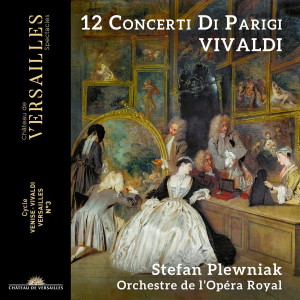
Antonio Vivaldi (1678-1741)
12 Concerti di Parigi
Orchestre de l’Opéra Royal/Stefan Plewniak
rec. 2020, Salle des Croisade, Château de Versailles, France
Château de Versailles Spectacles CVS065 [61]
Antonio Vivaldi was one of the most admired and influential composers of his time. Although he worked for most of his life in Venice, his music made its way across Europe, either in printed editions – most of which were published in Amsterdam – or in hand-written copies. Johann Sebastian Bach was one of many who studied them and whom they influenced in his way of composing concertos. As far as Vivaldi’s instrumental music is concerned, it is mostly his concertos with one or several solo parts that are performed today. However, his oeuvre also includes around forty concertos for strings and basso continuo without solo parts, known as ripieno concertos. To that number we can add pieces for the same scoring that are called sinfonia; these two descriptions are more or less exchangeable, as some pieces are called sinfonia in one source and concerto in another.
The present disc comprises twelve ripieno concertos that were intended as a set and are known as concerti di Parigi, as they have been preserved in the Bibliothèque Nationale de France. It has been thought that they were put together for Count Jacques-Vincent Languet de Gergy, French ambassador in Venice and an important patron of Vivaldi in the 1720s. It was also at his instigation that Vivaldi wrote the serenata La Senna Festeggiante. However, Olivier Fourés, in his liner-notes, mentions that recent research points in another direction. In 1728 the Habsburg emperor Charles VI, a great lover of music, visited Trieste, and Venice sent a delegation to the city, which included Vivaldi. The composer offered the emperor his concertos with the title of La Cetra and also met the 19-year old Franz Stephan, heir to the duchies of Lorraine and Bar, who in 1745 was to become Holy Roman Emperor. One year later Vivaldi sent him a collection of concertos. That may well have been the set known as concerti di Parigi. Franz Stephan played the harpsichord, and after having met Vivaldi he took violin lessons. “[As] the Duke did not have the level of proficiency required on the violin, Vivaldi preferred to avoid offence”, by omitting solo parts.
What is for sure is that these concertos were indeed put together: they seem not to have been especially written for Franz Stephan, but rather assembled from previously-written pieces. Ten of the twelve concertos are also known from the largest collection of Vivaldi’s music, which is preserved in Turin. The two exceptions are the second and the fifth concerto. The Concerto in C (RV 114) which opens this disc, was probably specifically written for this set. The third movement is a chaconne, a form that was very popular in France and included in every opera and in many instrumental works. Also notable is the very short middle movement: it is not more than a transition between the two fast movements. In this recording it takes just 13 seconds. The programme ends with the other ‘new’ piece, the Concerto in E minor (RV 133). It is unlikely that it was written for this set; Fourés rather thinks that it is an early work, dating from the 1710s, and that the original version may have been lost.
All the concertos are in the common three-movement form which is the standard in Vivaldi’s oeuvre, in the usual order fast – slow – fast. Even so, there is quite some variety in this corpus of ripieno concertos, and that is perfectly demonstrated here. Stefan Plewniak and his colleagues have found the right approach to these concertos. They emphasize the contrast between the fast and the slow movements, and that lends these performances a strong dramatic character. If one listens to these short pieces, one is not surprised that Vivaldi was one of the great opera composers of his time. I also like the marked dynamic shading between good and bad notes.
The ripieno concertos are often performed as fillers in programmes of music by Vivaldi, dominated by solo concertos. That does them hardly justice. This disc proves that they can stand on their own feet. There is not a dull moment here, thanks to Vivaldi and the engaging performances of the Orchestra of the Opéra Royal.
Johan van Veen
www.musica-dei-donum.org
twitter.com/johanvanveen
Contents
Concerto No. 5 in C (RV 114)
Concerto No. 4 in F (RV 136)
Concerto No. 11 in G (RV 150)
Concerto No. 1 in G minor (RV 157)
Concerto No. 12 in A (RV 159)
Concerto No. 10 in D (RV 121)
Concerto No. 6 in G minor (RV 154)
Concerto No. 7 in A (RV 160)
Concerto No. 3 in C minor (RV 119)
Concerto No. 9 in B flat (RV 164)
Concerto No. 8 in D minor (RV 127)
Concerto No. 2 in E minor (RV 133)
Help us financially by purchasing through




















